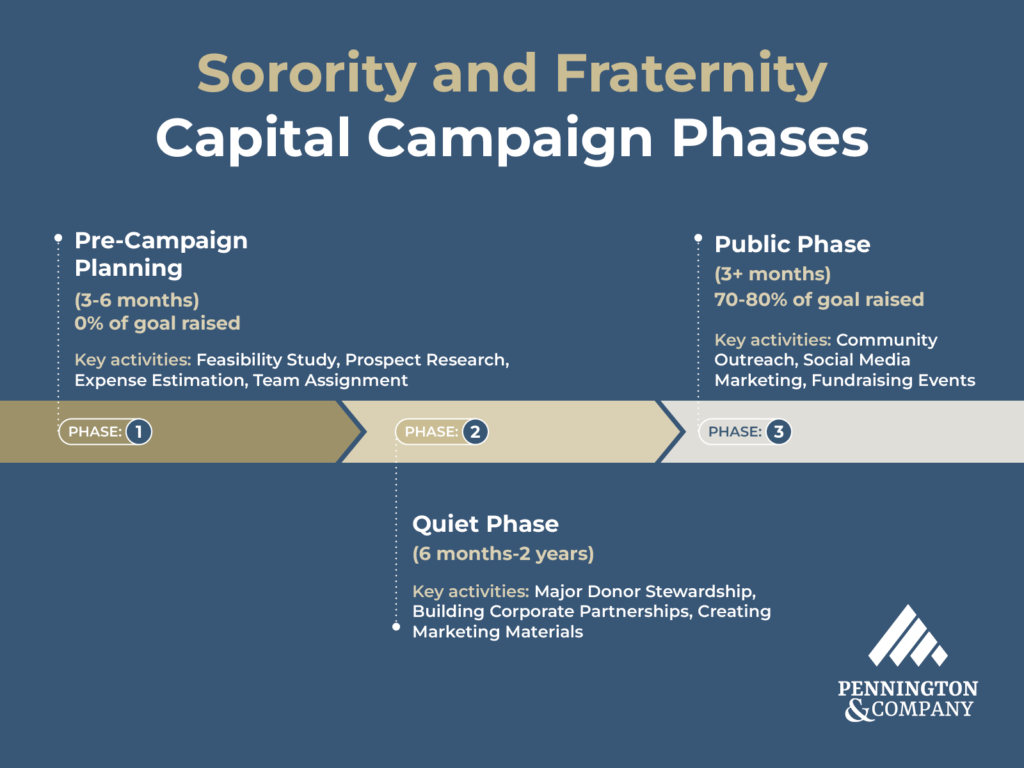Capital campaigns are lucrative sources of funds for large-scale projects for sororities and fraternities. However, they can be daunting to plan, execute, and iterate on in the future. That said, your deep connection with your alumni/ae uniquely positions you to run a successful capital campaign.
Whether it’s your first time running a capital campaign or you’re a seasoned pro, the tips in thie guide can help your fraternity or sorority play to its strengths and maximize your alumni/ae fundraising potential.
As we review these essentials, consider your fraternity or sorority’s alumni/ae makeup, interests, and preferences, as well as your previous approaches to capital campaigns. These factors will help you pinpoint which strategies have the most potential to make your capital campaign a success.
Strategically Segment and Personalize Donor Outreach
With all of the diversity at play in your chapter’s alumni/ae community, creating highly personalized messages for each of your members is time-consuming, and this is before considering your alumni/ae community’s makeup—you might be conducting outreach to Baby Boomers, Gen Zers, and everyone in between. Besides age, your alumni/ae donor community has a diverse array of professions, hobbies, and experiences with your chapter.
However, you can boost efficiency while preserving personalization by segmenting your alumni/ae communications. Here are some ways to accomplish this:
- Choose ideal criteria for capital campaign donors. You’ll need to hone the segmentation criteria that you use for regular fundraising campaigns to reach the right audience. To solicit , segment alumni/ae donors by their wealth, relationship with your chapter, and other factors that directly impact their capacity to give. Additionally, remember that you’ll need to reach out to donors who can give smaller gifts during the public phase of your campaign.
- Branch out into new communication channels. Adopting many communication channels allows you to cater to as many alumni/ae preferences as possible. In particular, you might put more time into your in-person channel for a capital campaign, as these interactions inherently provide more opportunities to forge and deepen donor relationships.
- Increasing personalization. Major donors require more relationship-building opportunities and maintenance than the average donor to renew their support. Add elements to your messages that are uniquely personal. For instance, if a capital campaign donor experiences a life milestone like a birthday or wedding anniversary, you could send them cards hand-written by current chapter leaders to show that you care about their personal lives.
Remember that, as the home for your donor data, your CRM is a crucial part of your segmentation and outreach efforts. Make it as useful and productive as possible by implementing data hygiene practices. NPOInfo’s guide to data hygiene for nonprofits suggests keeping your CRM clean and effective by planning regular data audits and appending missing data.
Implement a Phased Stewardship Plan
With most capital campaigns aiming to raise hundreds of thousands of dollars, it’s more realistic to conceptualize them as marathons, not sprints. Approaching your capital campaign in phases can help you structure, standardize, and sustainably achieve your fundraising goals.
Though all capital campaigns are unique in scale and strategy, there’s a standard cadence you can model your own campaign on. This diagram from Pennington & Company’s guide to capital campaigns visually lays out the standard structure for sorority and fraternity capital campaign phases:

- Pre-Campaign Planning Phase (3-6 months with 0% of goal raised). Key activities include a feasibility study, prospect research, expense estimation, and team assignment.
- Quiet Phase (6 months-2 years with 0% of goal raised). Key activities include major donor stewardship, building corporate partnerships, and creating marketing materials for the public phase.
- Public Phase (3+ months, or once with 70-80% of goal raised). Key activities include conducting community outreach, social media marketing, and hosting fundraising events.
These three phases provide a general framework for your sorority or fraternity to build off of. As you dive deeper into capital campaign planning, add details about your strategies for each phase so your approach aligns with your strengths and weaknesses.
Dynamically Set and Assess Performance
Sustaining fundraising momentum is a crucial yet challenging part of long-haul efforts like capital campaigns. By the time your campaign reaches the public phase, you’re nearly at your overall goal but might feel overwhelmed by the prospect of conducting fresh outreach. However, dynamically setting, assessing, and adjusting your strategies based on performance can help your fraternity or sorority stay the course and reach your capital campaign goal. Dynamic success assessment can help you solicit capital campaign gifts in the following ways:
- Enhanced flexibility: Your capital campaign’s extended timeframe means a lot can change between phases, both internally and externally. Regularly adjusting your goals means you can more easily correct for unexpected circumstances.
- Improved resource allocation: If your team finds that a certain strategy is working better than others, dynamic goal setting allows you to adjust your priorities and allocate more resources to that strategy. For instance, if you find that alumni/ae from a certain year are interested in pooling funds to make a large class gift, you could allocate more team time into cultivating relationships with that donor segment.
- Data-driven decision making: If you have the right data collection practices in place, you can use reassessment periods to reflect on your performance data and make any changes based on metrics if needed.
To integrate dynamic performance assessment into your fraternity or sorority capital campaign, decide on a regular cadence in your planning stage and determine which components you’ll analyze every time. Remember, even key metrics can change based on how your campaign is going, so you aren’t limited to the same performance indicators.
Throughout your fraternity or sorority’s capital campaign, don’t forget to evoke the common thread that many of your potential contributors share: a connection to your organization. By following these tips and stressing the opportunity to build a lasting legacy on future brothers and sisters, you’ll create a winning capital campaign that sustains momentum, engages donors, and allows you to fund your organization’s largest projects.
